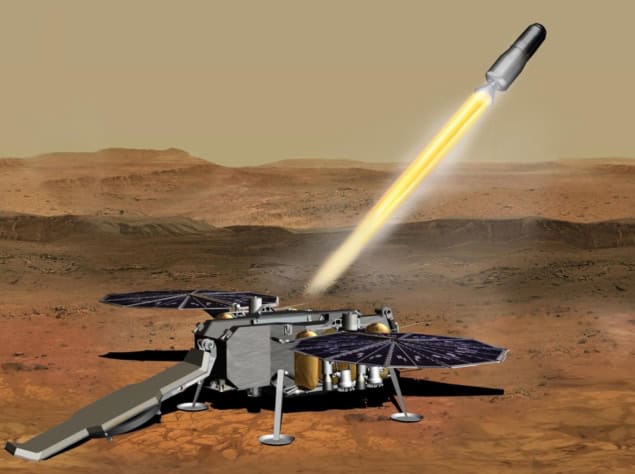
NASA is seeking alternative designs for its Mars Sample Return (MSR) mission, which is meant to bring back soil and rocks gathered by the agency’s Perseverance rover. But with the MSR beset by cost hikes and delays, NASA concedes that the current design is “too expensive” and that its aim of returning material by 2040 is “unacceptably too long”.
A partnership between NASA and the European Space Agency (ESA), the MSR is designed to return samples collected by Perseverance since 2021 at the Jezera crater on Mars. The material, once back on Earth, will boost our understanding of the red planet’s geological history and the evolution of its climate. It could also help with plans for future human explorers on Mars.
The MSR was given the highest scientific priority by the National Academies of Sciences Decadal Survey of Planetary Science in 2022. It consists of three parts: a Sample Retrieval Lander that will pick up samples deposited by Perseverance and put them in a container; a Mars Ascent Vehicle that will launch the container into Martian orbit; and ESA’s Earth Return Orbiter to ferry the samples to Earth.
Despite its importance, the MSR has fallen significantly behind schedule and gone vastly over budget. Originally planned to cost $4bn, that figure had ballooned to $5.3bn by 2022. A scathing report into the mission by NASA’s independent review board in September 2023 noted that NASA had “unrealistic” ideas about the MSR’s cost and schedule.
“There is no credible, congruent technical, nor properly margined schedule, cost and technical baseline that can be accomplished with the likely available funding,” the report concluded. It said there was a “near zero probability” that ESA and NASA could launch the mission by 2030 and warned that the MSR would cost $6–11bn – roughly the same as the James Webb Space Telescope. Samples would not reach Earth before 2040.
Lowering risk
After the report was released, NASA promised to set up a review panel to respond to its conclusions and “assess alternative architectures” for the mission. In a document released on 15 April, the four-person panel – led by deputy administrator for science Sandra Connelly – concludes that NASA needs to improve the accountability, authority, communication and co-ordination of the mission.
The panel calls on NASA to solicit ideas from industry and NASA institutions, recommending a detailed process to explore “out-of-the-box architecture and mission element options by releasing a competitive industry study solicitation as soon as possible”. Such options, the panel asserts, could make the mission cheaper, less complex and less risky, while returning the samples faster. In particular, the studies should include alternative designs for the Mars ascent vehicle that will lift the samples off the red planet’s surface.

NASA’s Mars Sample Return mission slammed by independent review panel
NASA administrator Bill Nelson admits that the 2040 date “is too far” away and hopes that the new plan should speed the mission up and make it cheaper. Nicola Fox – associate administrator of NASA’s Science Mission Directorate – adds that “it is imperative to return these valuable samples to Earth to be studied in state-of-the-art laboratories”. A successful sample-return effort will, she says, enable scientists to address key questions about Mars and “inspire future generations to pursue further investigations into questions not yet known”.
- Meanwhile, NASA has announced that the Dragonfly rotorcraft mission to Titan, a moon of Saturn that is rich in organic materials, will move towards its final design. The mission has a launch date of July 2028 with NASA expecting the craft to fly on Titan in 2034.



